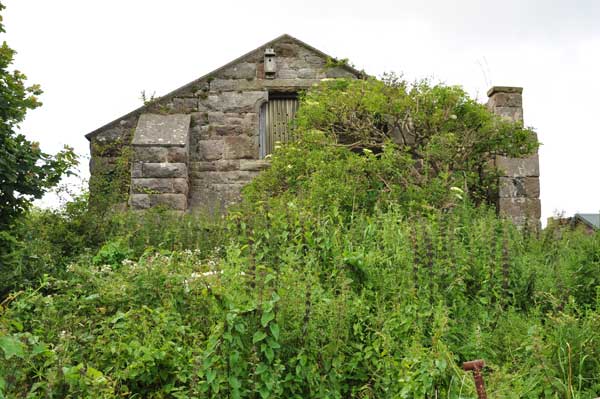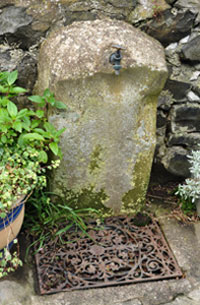 |
|
Archway - Tower Bank |
The Reservoir - 'Tank'
|
 |
Located above the coastguard cottages on Whin Hill, this building was Craster's reservoir until replaced by the modern system of supply. In 'We Can Mind the Time', Mary Craster wrote that Shafto Craster built the Tank and Joan Angus dated its construction to 1820.
Solidly constructed of whinstone, the structure was reinforced with external butresses to contain the stresses of the water stored inside. When in use, the only entrance was the wooden door visible in the photograph, some five or six feet above ground level. Internally, the walls were plastered to make them water-proof and the level of water was set at just below the bottom of the door. The internal floor level was some five feet below ground level, making the tank some ten or eleven feet deep. Gravity feed through a system of pipes conducted the water around the village.
|
The following photograph shows the water tank at the turn of the century, with the crenellations of the coatguard compound behind. The design is similar to the Georgian magazine near the barracks in Berwick upon Tweed. The external butresses around the walls serve to contain lateral forces from the water stored within on the one hand and the force of an explosion on the other.
|
|
For many years the village was served with water from this reservoir to a system of stand pipes around the village. The cottages were without running water. The photograph on the right shows what is left of the standpipe on the garden wall of one of the cottages on West End.
The photograph below shows the standpipe behind Chapel Row. Joyce Shaw, remembers her family, who lived on Chapel Row, using the sandstone plinth to sharpen their knives. This probably accounts for the shaped edges of the plinth. The ornate wrought iron grid could be an original feature.
|
An old photograph of the village shows a similar standpipe on the church wall at the top of Church Street. Unfortunately that has now gone. However the photograph clearly shows the barrels on the cobble pavements that were fed by pipes from the roof gutters, which were used to collect water for washing and laundry purposes.
The following memories were recorded in 'We Can Mind the Time'.
Adam Dawson: "There was no water in the houses, it came from a reservoir on top of a hill, there was a spring that used to fill this reservoir, but we used to be very, very careful with the water. We never used it for washing. Outside every house in Craster there was a barrel we used to have for washing the clothes and everything. We used to use rain water which was pure and clean. Everybody in Craster had a wash house outside, there used to be a steel pot - they used to fill that with rain water. Now underneath that we used coal and sticks to make a fire to boil the water. That was how we used to wash our clothes."
Winnie Hogg: "If it was a day when they weren't at the sea, my mother used to wash. Now that was another big job. We had a wash house. The night before they used to have a pot, which had to be lit early on to heat the water. From there the water was put into a big red barrel and then the clothes were put in and possed up and down. They were scrubbed, rinsed, put through a wringer, and put on the bushes, or a line up the top of the hills."
Adam Dawson also remembered the drying: "To dry our clothes we used to hang them out in the gardens or on the bushes or anything. Everything was that clean; nothing was dirty......In the houses there were racks to dry the clothes in the wintertime., that's where we used to hang them up and the heat from the fires, coal fires, used to dry the clothes."
Willie Archbold remembered the Square, "I lived there from December 1935 till I came out in June, 1954 and when we came out there was no water in the house, we had earth closets." and "There was a tap for seven houses and we had a barrel outside to catch the rainwater. There was a table alongside and we used to wash with the rainwater."
Winnie Hogg remembered the outside toilets with no affection: "They were terrible. They were nearly all painted in what was called 'netty' pink...Inside they were a deep pink and they smelled atrocious. They used to put down some kind of disinfectant, some sort of powder. They used to empty them at night. They used to put them down some sort of chute. We used to have a nail with newspaper onfor toilet paper."
The problems of an unsafe water supply were remembered by Joyce Shaw: "Apparently (many) people died of fever and it's in the Parish records. When I first read it I thought it was Scarlet Fever, but my granny said it was Enteric Fever, caused by the water and my aunt confirmed that and she said that the well was somewhere beside the kipper sheds, just below Michael Doherty's place. Apparently the water was infected because when they got piped water here, there was no more fever. The child mortality rate was high. You can see it in the family trees." (The location suggested is beside the old smokehouse on the harbour foreshore.)
The following is from the Northumberland Gazette of August 15th, 1952:
 |
 |
Home Programme Membership Archive War Memorials History Walk Miscellanea Links Contact Us



